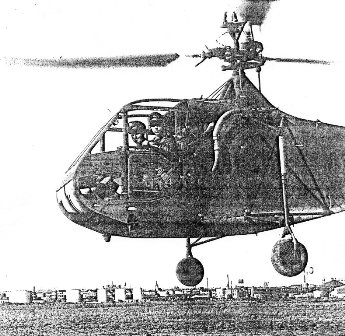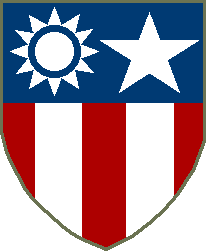
|
FIRST RECORDED MILITARY RESCUE BY HELICOPTER
The Hoverfly in CBI
The first recorded use of a helicopter as rescue aircraft by the U.S. Military took place in the
China-Burma-India Theater of World War II.
A Sikorsky-built R-4 helicopter was used in April 1944 in a dramatic rescue of a downed pilot and three wounded
soldiers in the jungles of Burma.
The fledgling aircraft was underpowered, which was only made worse by the heat and humidity of the jungle.
Three trips were necessary to evacuate the men.
The R-4 was first used in combat in May 1944, after which, Col. Philip G. Cochran, Commanding Officer
of the 1st Air Commando Group wrote to a friend, "Today the 'egg-beater' went into action and the damn thing acted like it had
good sense."
The R-4 Hoverfly was the world's first production helicopter.
The original military model, the XR-4, was developed from the famous experimental VS-300 helicopter,
invented and built by Igor Sikorsky and publicly demonstrated in 1940.
The XR-4 made its initial flight on January 13, 1942 and as a result of its successful flight tests, the Army
ordered 30 for additional service testing and flight training.
One went to Burma and one to Alaska, while the others were assigned to the U.S. Navy, U.S. Coast Guard and British Royal Navy.
They showed such promise that the Army Air Force ordered 100 more.
The R-4 was also used in other missions as liaison and an observation platform.
In January, 1945, the later YR-6 model was rushed to CBI "due to a critical situation concerning the rescue
of combat personnel in enemy held territory in the India-Burma Sector."
The orders, issued by General "Hap" Arnold, further stated that the helicopter be transported "by the most
expeditious means."
In a few short months the helicopter had gone from a testing and training aircraft to a critical necessity.
The R-6 provided search and rescue services in China during the final months of the war.
See the original orders
In 1943 few people knew what a helicopter was or what it might be capable of doing.
The first flight of a practical single-rotor helicopter had taken place only four years earlier, in 1939.
In December of 1940, Sikorsky was awarded a contract to develope helicopters for the military.
This led to development of the R-4, the world's first production helicopter.
The R-4 and its later R-5 and R-6 versions were the only helicopters used in action in World War II.
By war's end, 400 military helicopters had been built.
Alec von Voight grew up in Connecticut, where his father worked for Sikorsky Aircraft.
After graduating high school, Alec too went to work for Sikorsky Aircraft and was involved in the development of
the Hoverfly.
In 1943 he was inducted into the U.S. Army and sent to the Eastern Flight Training Command headquarters
at Maxwell Field, Alabama.
His story of his time in the Army and the Hoverfly in CBI . . .
Recollections of Alec von Voight
I arrived at Maxwell on November 1 and was invited to attend a two-day meeting that I soon
learned was the kickoff for the first military helicopter training program conducted by the U.S. Army.
Since no one at the meeting had ever heard of or seen a helicopter before I was questioned extensively about all
aspects of the new machine, from piloting to operations to maintenance.
I subsequently became the first military person assigned to the new U.S. Army Air Corps helicopter pilot training squadron.
To my great pleasure and surprise the program began at Sikorsky Aircraft.
One unforgettable assignment started on December 21, 1943 when my co-pilot and I took off from Bridgeport,
Connecticut in thirty mile headwinds for Andrews Air Base in Washington, D.C. where we were to demonstrate the new
helicopter technology to a select group of international military personnel.
We landed at Andrews near a very large, unfamiliar looking aircraft. Immediately military police surrounded us because
we had inadvertently parked near the first production B-29, which was shrouded in secrecy.
The following day we left for Pittsburgh, Pennsylvania, our next spot for layover and refueling.
We encountered snow squalls and reached Pittsburgh by nightfall.
In those days helicopters were airfield curiosities of steel tubing, fabric and lots of noise.
Everywhere we flew we would stop traffic and scare the hell out of farm animals because we were flying at only 500 feet
following the roads.
The next day we completed our 387 mile flight by delivering the first R-4B helicopter with its improved 200 horsepower
Warner engine to Wright Field, Dayton, Ohio.
Throughout these early years improvements were rapidly made in helicopter technology speed and stability increased,
engines were more powerful, range was extended and the R-4 was proving its worth as an effective aircraft for
reconnaissance and rescue.
In January of 1944 a U.S. Coast Guard helicopter flew urgently needed blood plasma to a first aid station on the beach
at Sandy Hook, New Jersey, where sailors from an exploded U.S. destroyer were being treated.
Despite 30 mile winds and low visibility, the R-4 was successful in its mission despite weather that had grounded all
fixed wing aircraft.
In April of 1944 an army version of the R-4 made the first aerial rescue under combat conditions.
A plane with the pilot and three wounded soldiers had crash landed behind enemy lines in the dense jungles of Burma.
The R-4 was taxed to its limits but it successfully evacuated the four under dangerous and adverse conditions.
In March of 1944 we set up the first helicopter pilot training school at Freeman Field, Seymour, Indiana,
and were eagerly awaiting the arrival of the first helicopters from the Sikorsky plant.
On June 8th we spotted two R-4 helicopters which flew over the field and landed directly in front of the control tower.
A new era in army aviation training had begun.
The initial course curriculum was based on a minimum of 25 flying hours and lasted four weeks.
It did not include training in night flying which was not deemed necessary at the time but was added later.
1944 through VJ Day in 1945 was a period of growth and change.
The school moved many times and today is located at Fort Rucker, Alabama.
In February of 1945 the Army Medical Corps revised its plans for the care of battlefield casualties to include the new
medical evacuation machine, the helicopter.
The new medical unit was called the Emergency Rescue Squadron (ERS).
Not only did we have the first new R-6 helicopters, we also had two C-47 planes modified for fly-by pickup with
special doors on the fuselage floor, two B-25's equipped with cameras and four Stinson L-5 light aircraft to aid in
locating, evacuating and treating casualties.
 R-6 of the 8th Emergency Rescue Squadron
R-6 of the 8th Emergency Rescue Squadron
|
The unit was designed to be completely mobile and self-sufficient and therefore included our own medical staff,
supplies and ground transportation.
The ERS was top secret because it was part of the buildup for the invasion of Japan.
In April 1945 we flew out of Chanute Field, Illinois, to our final destination, Kunming, China.
We traveled via Florida, to Brazil, across the Atlantic to Egypt, Arabia, India, Burma, and finally over the Hump
into China.
The rugged terrain and high altitude of the Himalayan Mountains would be a tough testing ground for the R-6's.
Kunming, at an altitude of 5,000 feet, was our main base.
Due to lower climate temperatures and a higher horsepower engine (245 HP Franklin), we could fly with a twenty foot
take-off.
To make the R-6's more operational we replaced the fuel tank with two L-5 wing tanks mounted externally on each side of
the fuselage.
We removed all radio equipment and cowling to gain performance.
Even with these modifications you never knew what was going to happen.
There was no such thing as a routine mission!
See the original Routing Sheet
On April 28th we learned that a C-46 transport was crossing the Hump when one engine failed.
It crashed with four airmen and eight soldiers aboard.
The search was handled from one of our C-47 transports and evacuation was accomplished by helicopter.
Within twenty-four hours of our arrival in Kunming we had successfully completed our first rescue mission.
In June of 1945 the army started converting Liberty ships into floating repair depots.
Special landing platforms were added to accommodate helicopters.
R-4's were used to transport items from ship to shore and, more importantly, to evacuate casualties from the front lines.
This was yet another example of the military's increased understanding of helicopter technology and how to best
utilize it.
The war over, I left China in October of 1945 and went on to get a degree in mechanical engineering.
My career in aviation continued when I became part of an engineering group that produced the first turbine engine
specifically for helicopters, the Lycoming T53.
During World War II, helicopter technology was new and used on a limited scale for patrol and rescue missions.
After the war military use of helicopters increased greatly leading to major improvements in their design.
New uses for the helicopter developed during the Korean War including armed observation of enemy positions and the
transportation of troops and supplies to hard-to-reach areas.
The helicopter proved its value in Korea when it was used to evacuate thousands of wounded soldiers quickly from the
battlefield, thus saving innumerable lives.
The role of the helicopter expanded still further during the Vietnam War when thousands of armed attack helicopters
flew combat missions.
The helicopter has become a valuable part of military and civilian life since its invention.
By Jean Garde Parker
|
|



 Carter Harmon (standing, on the left) who performed the first helicopter evacuation in a combat zone on
April 25, 1944, in the highlands of Northern Burma, poses with ground crew in front of the R-4 helicopter.
Carter Harmon (standing, on the left) who performed the first helicopter evacuation in a combat zone on
April 25, 1944, in the highlands of Northern Burma, poses with ground crew in front of the R-4 helicopter.
 The Sikorsky VS-316A (military designation R-4) was a definitive development of Igor Sikorsky's successful pre-war
VS-300, and in 1944 became the first helicopter in the world to be placed in series production.
The Sikorsky VS-316A (military designation R-4) was a definitive development of Igor Sikorsky's successful pre-war
VS-300, and in 1944 became the first helicopter in the world to be placed in series production.

 Sikorsky R-6A's attached to the 14th Air Force provided essential search and rescue services for aircraft crossing
"The Hump" into China during the final months of World War II.
Sikorsky R-6A's attached to the 14th Air Force provided essential search and rescue services for aircraft crossing
"The Hump" into China during the final months of World War II.

